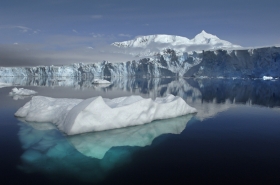Ice Sheets Coming and Going

There are many factors that can speed up or slow down climate caused changes in glaciers and ice sheets. Ice-sheet retreat can halt temporarily even during a long warming phases. A UK team led by Durham University has found that the geometry of channels beneath the ice can be a strong control on ice behavior, temporarily hiding the signals of ice retreat.
The findings, which provide the first simulation of past ice-sheet
retreat and collapse over a ten thousand year period in Antarctica, shed
new light on what makes ice stable or unstable and will help refine
predictions of future ice extent and global sea-level rise, the
researchers say.
The results of the new research from Durham University, the University
of Sheffield, the University of Cambridge, and British Antarctic Survey
are published this week in the journal Nature Geoscience.
Lead author, Dr Stewart Jamieson, a glaciologist at the Department of
Geography, Durham University, said: "Our research shows that the
physical shape of the channels is a more important factor in controlling
ice stability than was previously realized. Channel width can have a
major effect on ice flow, and determines how fast retreat, and therefore
sea-level rise, can happen."
Although climatic and oceanic changes are crucial drivers of ice loss,
the research shows that the landscape below the ice strongly controls
the speed of any retreat.
Dr Jamieson added: "Our results suggest that during an overall phase of
retreat an ice stream can appear almost stable when in fact, in the
longer-term, the opposite may be the case."
Marine-based ice streams are the fast flowing arteries of ice sheets,
draining approximately 90 per cent of the ice that reaches the sea. They
flow through large channels where the ice can move thousands of meters
in a year. According to the scientists, the unpredictable nature of ice
streams makes forecasting ice-sheet retreat extremely difficult. If ice
streams speed up they can cause sea level to rise.
An ice stream is a region of an ice sheet that moves significantly
faster than the surrounding ice. Ice streams are a type of glacier. They
are significant features of the Antarctic where they account for 10% of
the volume of the ice. They are up to 50 km wide, 2 km thick, can
stretch for hundreds of kilometers, and account for most of the ice
leaving the ice sheet.
The speed of an ice stream can be over 1,000 meters per year, an order
of magnitude faster than the surrounding ice. The shear forces at the
edge of the ice stream cause deformation and recrystallization of the
ice, making it softer, and concentrating the deformation in narrow bands
or shear margins. Crevasses form, particularly around the shear margins.
Satellite imagery from the last 20 years has led to advances in our
knowledge of ice sheet stability and has shown that many ice streams are
getting thinner and retreating because the ocean and climate are
warming. The new research shows that ice behavior can successfully be
simulated in places where ice streams meet the sea.
The researchers looked at the landscape of the seafloor in Marguerite
Bay, in the Antarctic Peninsula, and saw that during a rapid phase of
recession 13,000 years ago, retreat paused many times.
Many ice streams are found in channels with beds that are below sea
level and that deepen inland. Current theory suggests that ice loss can
increase rapidly in deeper water, but the new findings show that channel
width plays a crucial role and that narrow bottlenecks in the landscape
beneath the ice can cause retreat to slow down.
For further information see
Ice Streams.
Glacier by Pete Bucktrout. image via British Antarctic Survey
©2012. Copyright Environmental News Network To subscribe or visit go to: http://www.enn.com